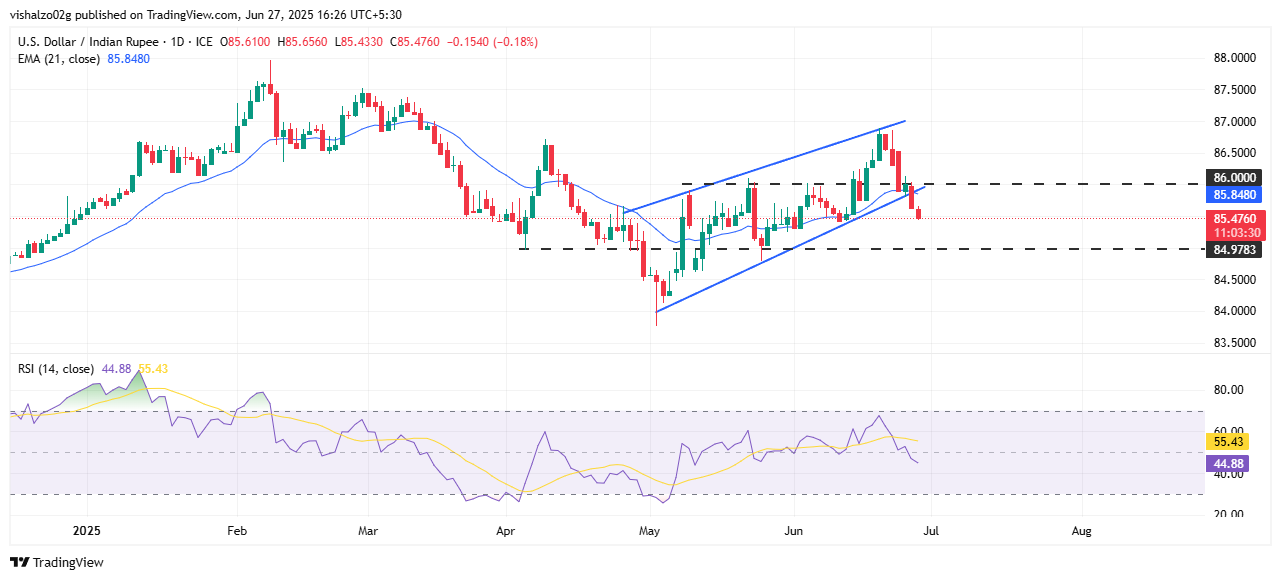Created
: 2025.06.27














![]() 2025.06.27 20:59
2025.06.27 20:59
The Indian Rupee (INR) strengthens further on Friday, riding a wave of US Dollar (USD) weakness, as the Greenback slides further amid political noise and soft economic prints. US President Donald Trump's fresh criticism of Federal Reserve (Fed) Chair Jerome Powell, paired with weaker-than-expected US Q1 Gross Domestic Product (GDP) data released on Thursday, is weighing heavily on the Greenback. As a result, the US Dollar Index (DXY) remains pinned near a three-year low, boosting demand for emerging market currencies such as the Rupee.
USD/INR is under pressure, slipping to near two-week lows around 85.50 during the European hours. The US Dollar Index (DXY), however, remains steady near 97.24, hovering close to the three-year low marked on Thursday, as traders await May's core Personal Consumption Expenditures (PCE) Price Index data, the Fed's preferred inflation metric, set to be released at 12:30 GMT.
President Trump's pointed criticism of Fed Chair Powell has sparked renewed doubts about the central bank's independence, prompting traders to increase interest rate cut bets. There's growing chatter that Trump could try to influence policy through a "shadow chair"--an unofficial figure position to influence the Fed's policy direction until Jerome Powell's term ends in May 2026.
Markets were quick to react, with traders on Thursday boosting bets on interest rate cuts. According to CME Group data, the probability of three cuts this year has climbed to around 60%, up from just two cuts expected earlier in the week.

The USD/INR pair has decisively broken below the lower boundary of the rising channel it had been respecting since early May, indicating that bears have the upper hand. The pair is currently trading around 85.48, slipping below the 21-day Exponential Moving Average (EMA) at 85.84--a bearish technical signal.
The break below the psychological support at 86.00 has opened the door for a test of the next horizontal support near 85.00, marked by previous consolidation levels. A strong daily close below the current level of 85.50 could accelerate downside momentum toward 85.00 and possibly 84.50 in the coming sessions.
The Relative Strength Index (RSI) has dropped to 44.88 and continues to slope downward. This confirms waning bullish momentum and hints at more downside ahead unless buyers reclaim the 85.85-86.00 zone.
The Indian Rupee (INR) is one of the most sensitive currencies to external factors. The price of Crude Oil (the country is highly dependent on imported Oil), the value of the US Dollar - most trade is conducted in USD - and the level of foreign investment, are all influential. Direct intervention by the Reserve Bank of India (RBI) in FX markets to keep the exchange rate stable, as well as the level of interest rates set by the RBI, are further major influencing factors on the Rupee.
The Reserve Bank of India (RBI) actively intervenes in forex markets to maintain a stable exchange rate, to help facilitate trade. In addition, the RBI tries to maintain the inflation rate at its 4% target by adjusting interest rates. Higher interest rates usually strengthen the Rupee. This is due to the role of the 'carry trade' in which investors borrow in countries with lower interest rates so as to place their money in countries' offering relatively higher interest rates and profit from the difference.
Macroeconomic factors that influence the value of the Rupee include inflation, interest rates, the economic growth rate (GDP), the balance of trade, and inflows from foreign investment. A higher growth rate can lead to more overseas investment, pushing up demand for the Rupee. A less negative balance of trade will eventually lead to a stronger Rupee. Higher interest rates, especially real rates (interest rates less inflation) are also positive for the Rupee. A risk-on environment can lead to greater inflows of Foreign Direct and Indirect Investment (FDI and FII), which also benefit the Rupee.
Higher inflation, particularly, if it is comparatively higher than India's peers, is generally negative for the currency as it reflects devaluation through oversupply. Inflation also increases the cost of exports, leading to more Rupees being sold to purchase foreign imports, which is Rupee-negative. At the same time, higher inflation usually leads to the Reserve Bank of India (RBI) raising interest rates and this can be positive for the Rupee, due to increased demand from international investors. The opposite effect is true of lower inflation.
![]()
Created
: 2025.06.27
![]()
Last updated
: 2025.06.27

FXStreet is a forex information website, delivering market analysis and news articles 24/7.
It features a number of articles contributed by well-known analysts, in addition to the ones by its editorial team.
Founded in 2000 by Francesc Riverola, a Spanish economist, it has grown to become a world-renowned information website.
We hope you find this article useful. Any comments or suggestions will be greatly appreciated.
We are also looking for writers with extensive experience in forex and crypto to join us.
please contact us at [email protected].
Disclaimer:
All information and content provided on this website is provided for informational purposes only and is not intended to solicit any investment. Although all efforts are made in order to ensure that the information is correct, no guarantee is provided for the accuracy of any content on this website. Any decision made shall be the responsibility of the investor and Myforex does not take any responsibility whatsoever regarding the use of any information provided herein.
The content provided on this website belongs to Myforex and, where stated, the relevant licensors. All rights are reserved by Myforex and the relevant licensors, and no content of this website, whether in full or in part, shall be copied or displayed elsewhere without the explicit written permission of the relevant copyright holder. If you wish to use any part of the content provided on this website, please ensure that you contact Myforex.
Myforex uses cookies to improve the convenience and functionality of this website. This website may include cookies not only by us but also by third parties (advertisers, log analysts, etc.) for the purpose of tracking the activities of users. Cookie policy